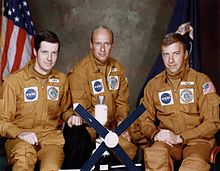Skylab 2

Skylab, seen from the departing Skylab 2 spacecraft
|
|
| Operator | NASA |
|---|---|
| COSPAR ID | 1973-032A |
| SATCAT no. | 6655 |
| Mission duration | 28 days, 49 minutes, 49 seconds |
| Distance travelled | 18,500,000 kilometers (10,000,000 nautical miles) |
| Orbits completed | 404 |
| Spacecraft properties | |
| Spacecraft | Apollo CSM-116 |
| Manufacturer | North American Rockwell |
| Launch mass | 19,979 kilograms (44,046 lb) |
| Crew | |
| Crew size | 3 |
| Members | |
| Start of mission | |
| Launch date | May 25, 1973, 13:00:00 UTC |
| Rocket | Saturn IB SA-206 |
| Launch site | Kennedy LC-39B |
| End of mission | |
| Recovered by | USS Ticonderoga |
| Landing date | June 22, 1973, 13:49:48 UTC |
| Landing site | 24°45′N 127°2′W / 24.750°N 127.033°W |
| Orbital parameters | |
| Reference system | Geocentric |
| Regime | Low Earth |
| Perigee | 428 kilometers (231 nautical miles) |
| Apogee | 438 kilometers (237 nautical miles) |
| Inclination | 50.0 degrees |
| Period | 93.2 minutes |
| Epoch | June 4, 1973 |
| Docking with Skylab | |
| Docking port | Forward |
| Docking date | May 26, 1973, 09:56 UTC |
| Undocking date | May 26, 1973, 10:45 UTC |
| Time docked | 49 minutes |
| Docking with Skylab | |
| Docking port | Forward |
| Docking date | May 26, 1973, 15:50 UTC |
| Undocking date | June 22, 1973, 08:58 UTC |
| Time docked | 26 days, 11 hours, 2 minutes |
|
 L-R: Kerwin, Conrad, and Weitz
Skylab program
|
|

Due to a NASA management error, manned Skylab mission patches were designed in conflict with the official mission numbering scheme.
Skylab 2 (also SL-2 and SLM-1) was the first manned mission to Skylab, the first U.S. orbital space station. The mission was launched on a Saturn IB rocket and carried a three-person crew to the station. The name Skylab 2 also refers to the vehicle used for that mission. The Skylab 2 mission established a twenty-eight-day record for human spaceflight duration. Furthermore, its crew were the first space station occupants ever to return safely to Earth – the only previous space station occupants, the crew of the 1971 Soyuz 11 mission that had manned the Salyut 1 station for twenty-four days, were killed during reentry.
The manned Skylab missions were officially designated Skylab 2, 3, and 4. Miscommunication about the numbering resulted in the mission emblems reading Skylab I, Skylab II, and Skylab 3 respectively.
The Skylab station suffered significant damage on its May 14 launch: its micrometeorite shield, and one of its primary solar arrays had torn loose during launch, and the remaining primary solar array was jammed. Without the shield which was designed to also provide thermal protection, Skylab baked in the Sun, and rising temperatures inside the workshop released toxic materials into the station's atmosphere and endangered on-board film and food. The first crew was supposed to launch on May 15, but instead had to train practicing repair techniques as they were developed by the engineers. Ground controllers purged the atmosphere with pure nitrogen four times, before refilling it with the nitrogen/oxygen atmosphere for the crew.
On May 25, Skylab 2 lifted from LC-39B, the first Saturn IB launch in almost five years and only the second-ever launch from Pad 39B. Booster performance was nominal except for one momentary glitch that could have threatened the mission - when the Commit signal was sent to the Saturn at ignition, the instrument unit sent a command to switch the launch vehicle from internal to external power. This would have shut down the Saturn's electrical system, but not the propulsion system and likely cause the disaster scenario of an uncontrollable booster, requiring the Launch Escape System to be activated and the Command Module pulled away to safety, followed by Range Safety destroying the errant launch vehicle. However, the duration of the cutoff signal was less than one second, too short a time for the electrical relay in the booster to be activated, thus nothing happened and the launch proceeded as planned. This glitch was traced to a modification of the pad electrical equipment and corrective steps were subsequently taken to prevent it from happening again. On reaching the station, Conrad flew their Apollo Command/Service Module (CSM) around it to inspect the damage, then soft-docked with it to avoid the necessity of station keeping while the crew ate, and flight controllers planned the first repair attempt. Then they undocked so that Conrad could position the Apollo by the jammed solar panel, so that Weitz could perform a stand-up EVA, trying to free the array by tugging at it with a 10-foot hooked pole, while Kerwin held onto his legs. This failed, and consumed a significant amount of the Skylab's nitrogen maneuvering fuel to keep it steady in the process.
...
Wikipedia
